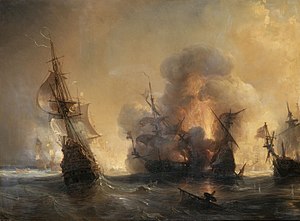Battle of Lagos (1693)
| Battle of Lagos | |||||||
|---|---|---|---|---|---|---|---|
| Part of the Nine Years' War | |||||||
 Battle of Lagos by Théodore Gudin |
|||||||
|
|||||||
| Belligerents | |||||||
|
|
|
||||||
| Commanders and leaders | |||||||
| Anne Hilarion de Tourville | George Rooke | ||||||
| Strength | |||||||
|
approx 100 sail, of which 70 ships of the line |
16 sail, of which |
||||||
| Casualties and losses | |||||||
| no ships lost | 90 merchantmen, of which 40 captured; 2 Dutch 64-gun warships captured |
||||||
approx 100 sail, of which
16 sail, of which
8 English,
5 Dutch ships of the line
The Battle of Lagos was a sea battle during the Nine Years' War on 27 June 1693 (17 June 1693 O.S.), when a French fleet under Anne Hilarion de Tourville defeated an Anglo-Dutch fleet under George Rooke. Rooke's squadron was protecting the 'Smyrna convoy', and it is by this name that the action is sometimes known.
In the spring of 1693, a large convoy was organized to transport English and Dutch merchant ships which were bound for Spain and the Mediterranean; they had been held back by the threat of attack by the French fleet, or by commerce raiders.
The convoy, consisting of upwards of 200 sail, was to be escorted by a strong squadron of eight English and five Dutch ships of the line, with fireships, scouts and other auxiliaries, under the command of Admiral George Rooke. This squadron was bound for the Mediterranean, to take up station there. The convoy was to be covered by the combined allied fleet for its passage across the Channel, until it was past the port of Brest, to guard against attack by the French stationed there. The fleet, which was also charged with protecting England from the threat of invasion, would then double back to cover the Channel.
The French, however, whilst they had made good their losses of the previous year, had abandoned the intent to invade in favour of a guerre de course, a war against the allies' trade and commercial interests.
To this end, Louis XIV had dispatched the French fleet under Tourville, his most able commander, to set an ambush for the convoy before it entered the Straits of Gibraltar. By the end of May, Tourville had assembled a fleet of 70 ships of the line, plus fireships, stores vessels and other auxiliaries, about 100 sail in total; and taken up station near Lagos Bay in Portugal.
The convoy sailed at the end of May, with the allied fleet of 24 Dutch warships under Philips van Almonde and 45 English under a leadership committee of Vice Admiral Henry Killigrew, Sir Ralph Delaval and Cloudesley Shovell.
...
Wikipedia
